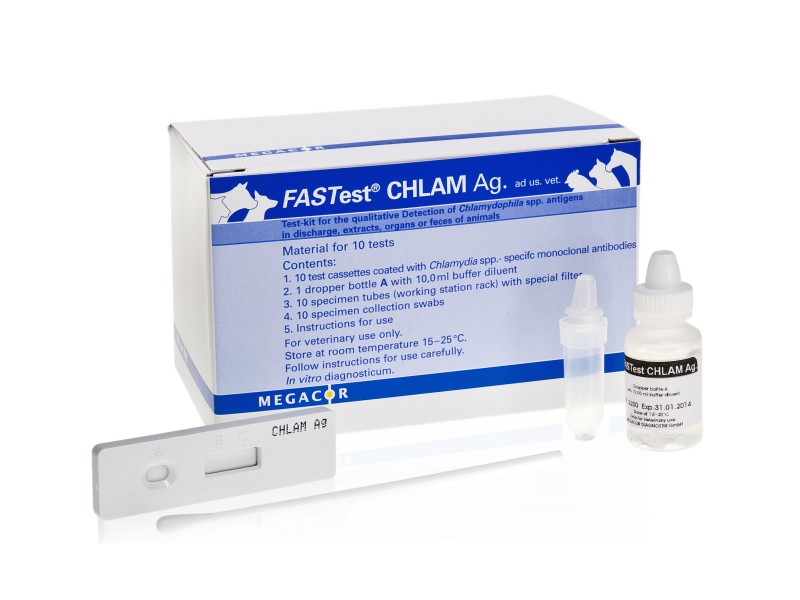Description
Qualitative Detection Of Chlamydia spp. Antigens
Test applicable to: Dog, Cat and Birds
Sample: Tears, Saliva and Nasal Discharge
FASTest CHLAM Ag is a rapid immunochromatographic lateral flow test for the detection of Chlamydophila spp antigen in different exudates, extracts of organs and faeces of animals. Due to the highly infectious and zoonotic potential of Chlamydophila spp and the wide prevalence in species, all animals with suspicion of chlamydiosis should be tested using FASTest CHLAM Ag.
Fast Aetiological Diagnosis
FASTest CHLAM Ag gives the veterinarian a fast aetiological diagnosis of a Chlamydophila spp. infection which is particularly useful considering the non-specific signs and the associated high infection risk for animals and humans. Furthermore, appropriate treatment, vaccination and quarantine measures can be initiated immediately after a positive diagnosis.
FASTest CHLAM Ag Product Information – PDF Download
Why Test?
Why is it important to test for Chlamydia?
Chlamydia is a world-wide spread group of obligate intracellular bacteria in a wide range of species of animals and also humans. Chlamydia with zoonotic potential in mammals is C. psittaci, C. abortus, C felis and probably C. pneumoniae. In practice, special attention should be given to the chlamydiosis of the cat, birds (psittacosis or ornithosis), and sheep or cattle (abortion).
Chlamydiosis of Birds
Chlamydiosis of birds (psittacosis, ornithosis; C. psittaci) is present in numerous bird species, but especially in parrots and parakeets (Psittacidae). Psittacosis is an epizootic and notifiable disease, depending on the country. Infection can be caused by contact with contaminated faeces, nasal discharge and dust.
Chlamydiosis of Cats
Chlamydiosis of the cat (C. felis) is important, especially in the coryza complex. In particular, kittens between 2 and 12 months of age are predisposed to the disease. The infection normally occurs via direct contact or droplet infection. Typically serous-purulent conjunctivitis with strong chemosis is shown unilaterally, sometimes also bilaterally. Due to the zoonotic potential, all animals of the litter should be tested and positive cases treated according to the ABCD guidelines and vaccinated after the clinical symptoms have disappeared (non-core vaccination). Untested and untreated animals can develop a latent carrier status with possible recurrences.
Chlamydiosis of Dogs
Chlamydiosis of the dog (C. psittaci, C. felis, C trachomatis, and C. caviae) is often not considered by the veterinarian due to the variety of clinical signs presented. Present prevalence figures are not available but experts assume a high estimated number of unknown cases.
Symptoms
What are the symptoms of Chlamydia?
Clinical signs of Chlamydophila differ depending on the animal.
Symptoms in Birds
- Ruffled feathers
- Emaciation
- Conjunctivitis including inflammation of the upper respiratory tract with eye
- Nasal discharge to light green coloured faeces
- Diarrhoea
In some severe case possible death
Symptoms in Cats
Conjunctivitis, abnormal eye discharge due to the inflammation of the conjunctiva. A watery discharge is present as the infection spreads and the conjunctiva will become reddened and swollen with the discharge from them becoming thicker. There is also a possibility that it may spread to both eyes.
- Low-grade Fever
- Sneezing
- Nasal discharge
Symptoms in Dogs
- Fever up to 42˚C
- Bronchopneumonia
- Cough
- Keratoconjunctivitis
- Loss of appetite
- Diarrhoea
- Vomiting
- Tonic-clonic attacks
Instructions For Use
Instructions For Use
Fastest CHLAM Ag Instructions For Use


